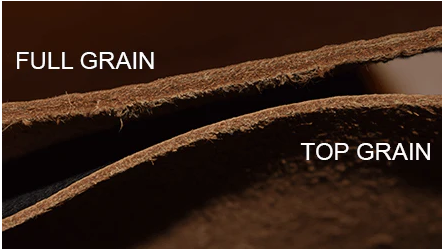
Secret Revealed between Full Grain Leather, Genuine Leather vs. Split Leather
Do you ever wonder: "What is the difference between Full Grain Leather, Genuine Leather or Split Leather, or "What is the difference between Cowhide Leather vs Split Leather?" Did you wonder what the meaning of "split leather" or as some call it, "split grain leather"actually is and if embossed leather or pu leather is still considered real leather?
Why do so many people associate Genuine Leather with the assumption that this product, that clearly says it in its name, "genuine leather", with the highest quality leather and something truly "genuine", after all, the name does exactly imply that and people think that it is the best and only true quality leather. What if that was not completely accurate but a clever marketing twist to make you believe that you're buying a top quality, genuine leather product? Technically genuine leather IS real leather, but what you are looking for are these words - Full Grain Leather.
If you wanted to know what the difference is between Full Grain Leather, Top Grain Leather, Genuine Leather or Split Leather this article will reveal the secrets behind those big words - let's start with - more questions!
More Questions!
- Which one is the best quality leather?
- Which type of leather lasts the longest?
- Genuine leather vs full grain leather, what's the difference?
- Is full grain leather or top grain leather the best?
- Is pu leather real leather?
- Is split leather good leather?
- Most importantly - which type of leather do I want and what is the intended use of the leather product?
Why are there so many words for "leather"? Is leather not just leather? True, leather is leather, all falling under the term "Genuine Leather", but generally, leather is categorized and defined into these four types of leather:
- Full-grain leather
- Top-grain leather
- Genuine leather
- Split leather
- Bonded leather
Let's start with the hide, leather hides (rawhide) have to be sliced/split because a hide is generally too thick (between 6 - 10 mm) to be used in almost any type of manufacturing. They are usually sliced to get about 4-5 layers out of them. Here are the five different layers or types of leather with a brief description and their unique characteristics.

The below diagram shows the different layers of leather. You can see the overlap of Full Grain Leather and Top Grain Leather, both are top quality leathers that are used to manufacture different products.
As you go further down the line you see how the density of the leather changes, making it less durable and more prone to tears and losing its shape. Here we see the term "Split Leather" being used. It also includes a smaller portion of the "Top Grain Leather" layer. The conclusion is; if you use the strongest, most dense, best, top quality layer, the Full Grain Leather, you would not just label your product as "Genuine Leather" but state that it is of the highest quality leather money can buy, namely "Full Grain Leather".

Let's recap and look at the different layers again:
Full Grain Leather
The first layer that is sliced/split off the rawhide is called Full Grain leather. That is the highest quality grade of leather and the part that is the most durable since it actually had to protect the animal from all the elements. It is also the most expensive part of the hide, that is what we use to create our beautiful DiLoro leather wallets, leather pen holders and leather pencil cases, leather watch cases, or your high-end leather backpacks, leather briefcases and leather handbags, just to give you a few examples. This is the type of leather that will develop a beautiful patina over time and will only become more beautiful with age. However, this part of the leather will also show 'imperfections' such as healed scars, insect bites, wrinkles, veining, etc. all of which are natural characteristics of Full Grain Leather, and that's exactly what gives it that unique, one-of-a-kind look.
Top Grain Leather
The next layer will be the Top Grain leather, also known as Embossed Corrected-grain leather, which is still good quality leather. It does not have the same characteristics and uniqueness that the full grain leather has. In most cases this top grain layer has had an artificial grain applied to its surface since it has been sanded and buffed to take away imperfections. With the top layer removed, the Top Grain Leather will have a more uniform finish, but it won't be as durable as full grain leather.
Split Leather
Genuine leather is typically a split grain or bonded material also known under the general term Genuine Leather. It is created from the fibrous part of the hide left once the top-grain of the rawhide has been separated, or split from the hide. Split or Genuine leather usually has an artificial layer applied to the surface and is embossed with a leather grain (bycast leather). Split leather is also used to create suede. The strongest suede is usually made from 'grain' splits (that have the grain completely removed) or from the 'flesh' split that has been shaved to the desired thickness. Suede is "fuzzy" on both sides and it had its moments of fame depending on the fashion trends.

Bonded Leather
Last and in this case, least, Bonded leather. Made from leftover scrap pieces of leather including dust and shavings that are shredded to a pulp. These shreds are than bonded together using polyurethane or latex on top of a fiber sheet. There’s no way of telling the level of organic leather material versus chemical.

We are always very happy to answer your queries regarding our leathers, so if this article has sparked a question for you, please do not hesitate to get in touch.
Guangzhou CM Luggage Leather Products Co. Ltd
Amelia
E-mail: cm-amelia@cmleatherproducts.com
Phone/whatsApp/skype/wechat: +8618811849436